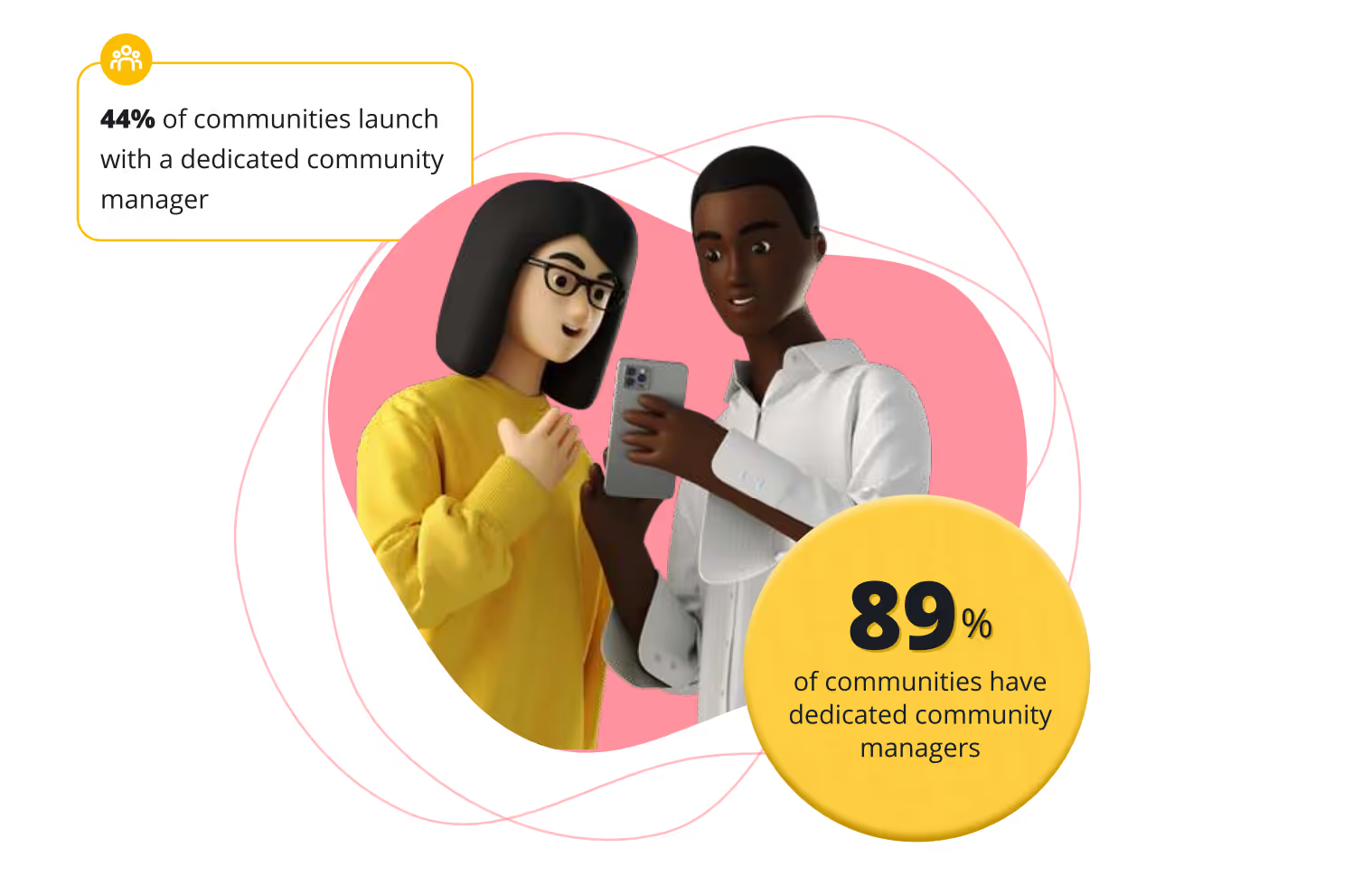How to Create a Winning Community Management Strategy
With the rise in the desire for authentic connections, more and more companies are taking a closer look at community management.
And it's no wonder that this shift is happening. As society becomes increasingly connected, people want to interact with brands in ways that feel meaningful and personal. Thus, many companies realize it's not enough to post content on social media—it takes more than that for customers to feel truly engaged.
As such, companies are turning to community management to better connect with their customers. After all, building and nurturing a community gives you plenty of prospects to grow your brand, paving the way to lead generation. But more importantly, it allows you to connect directly with your customers.
With that said, many businesses still don't know where to start when it comes to managing their communities successfully. Community management is a process with many moving parts, and there are so many things to consider before you even begin.
That's why we decided to put together this beginner's guide. In it, we will cover everything you need to know about what community management is and how to set your community management strategy in place.
What is Community Management?
Community management is the act of managing a community, whether that's a group of people who have come together online or in person.
It is the practice of engaging with your members to foster a sense of community and increase its overall growth. But it's not just about monitoring activity; it's also about understanding that activity so you can make sure people feel their voices are being heard.
It is a vital part of any business's marketing strategy because it helps you understand how your customers feel about your brand—and it helps them feel like they're part of something bigger than themselves.
Why is Community Management Important?
Community management is an essential part of any business. It's not just a nice-to-have—it's a must-have because it brings benefits to the company that is hard to replicate through other means.
Think of it as the backbone of your community, as it's how you get to know and understand your customers. Without it, you won't have a clear picture of your customer's needs and desires. You'll have no way to understand what drives them. And without that understanding, it's impossible to create products and services that people will love.
One way to tell the importance of it is by looking at the SPACES Model developed by CMX. This model defines a community's business value in terms of six categories: Support, Product, Acquisition, Contribution, Engagement, and Success. By looking at these categories individually, you can see how different aspects of your community management strategy contribute to your bottom line.

What Is the Difference Between Community Management and Social Media Management?
While community management and social media management are often used interchangeably, they aren't the same thing. They do have some overlap, but these two roles have very different goals and responsibilities:
- Social media management is a subset of community management focusing specifically on social networks like Facebook, Twitter, and Instagram. Social media managers are responsible for posting content and responding to comments on these platforms, but they don't necessarily have the same level of insight into your audience's needs as someone who manages an online or offline community.
- Community management is about cultivating a sense of belonging and fostering relationships between your company and its customers. They help members find value in being part of the community by giving them opportunities to interact with each other and share information.
How To Build A Successful Community Management Strategy From Scratch

If you're looking to build a loyal and thriving community for your business, it's important to have a community management strategy in place. This will help you create a solid foundation for your community and ensure that it grows in the right direction.
To help you get started with your own, we've compiled the six key steps you need to take to build a thriving strategy.
Understand Your Audience
First and foremost, you need to know exactly who you're trying to reach and why they'll want to connect with you.
You need to know who they are, what they want, and how they communicate. You'll also need to understand the type of content that resonates with them and how to use it to build trust and engagement.
Start by creating a list of who your audience is, and why they would want to join you. Consider everything from their age to their location and interests. The best way to do this is by conducting research—you'll learn more about your audience and what they want from you (and how they want it). You can also ask them directly through surveys or focus groups.
Once you have this information, use it to create a profile of your ideal member. Then, use this profile as a guide when inviting new members and engaging with existing ones.
Determine How You'll Identify Success and Set Measurable Goals
Once you've built a profile of your ideal member, it's time to set goals.
If you want your strategy to succeed, you need to determine how you'll know when it's working. That means setting measurable goals and then putting a plan in place to achieve them.
You can start by defining what success will look like for your community. For example, does it mean that all members actively use the community and engage with others? Or does it mean that members share content, provide valuable feedback and engage in conversations?
Once you know what success will look like for your community, set goals for each metric. These goals will vary depending on the size and scope of your organization and its needs, and they'll likely change over time too!
Use the goals to guide your community development efforts and make sure that you have a plan in place for how to achieve them. If you are struggling with setting clear metrics, we recommend you use the North Star Framework. It will guide you through the process of defining your goals and setting metrics that will help you achieve them.
Provide Value Through Education, Entertainment, and Other Forms of Engagement
Your community is made up of people who are interested in what you have to say. And they are interested in the things your company and community offer.
This is why it's essential to think about how you can provide value at every stage of your strategy.
Keep an eye on your members and ensure you give them what they want. You can do this by regularly surveying and asking them questions about their experience with you, their expectations of the community, and how they would like to see it grow in the future.
Once you have this information, you can deliver value to your members in many ways. You can publish educational materials, host events, webinars, or contests, and provide a place for lively discussion.
Be Consistent and Engage Regularly
When it comes to community management, consistency is key.
You should be engaging with your members on a frequent basis, whether online or in person. Regularly posting updates, responding to comments on discussion boards and forums, and asking questions can help you build relationships and create a sense of belonging among members.
One of the best ways to ensure consistent engagement is by hosting events like webinars or meetups where members can interact with each other and brand representatives. These events will give everyone something to look forward to, as well as an opportunity to contribute their ideas and feedback.
Additionally, you need to be consistent in your messaging, tone, and the types of content you post. If you’re going to be a community-led company, then every interaction between your brand and its members needs to feel like it comes from the same place. This helps build trust and loyalty, which are critical to the longevity of any space.
Determine What Tools Will Help You Achieve Your Goals
You'll need to decide which tools will be most effective in helping you achieve your community management goals. This will depend on the type of community that you're building, as well as where members are interacting with each other.
For instance, if you're running a community that relies heavily on hosting events, workshops, and monthly meetups, then a virtual conference platform might be the best option.
A platform like Bevy will allow you to manage all of these events in one place and even help you create an agenda for each one. It will also make it easier for your community members to register for your gatherings, and see what's coming next. Another benefit of using Bevy is that it empowers your local brand advocates to host more community-led events around your brand. This will help you connect with them on a deeper level and build stronger connections within the community.
On the other hand, if you're looking to create an online community where members can share their knowledge and expertise, then a forum or discussion board might be the right choice.
In this case, it's best to choose a platform that allows you to create an online community with multiple discussion boards. This will make it easier for you to set up different categories, topics, or areas of expertise that can be discussed within each board.
Monitor and Measure Success
Now that you've built a strong foundation for your strategy, it's time to think about the most important aspect: monitoring and measuring success.
If you're just getting started, it's best to start small and build up from there. You can use a community health survey to determine how your members feel about the community, what they're looking for, and how satisfied they are with their experience.
As you monitor, you'll be looking for trends in the data that show you where your efforts are paying off and where they're not. You'll also want to identify specific metrics that demonstrate success so that you can make sure those numbers stay high as you continue to grow and improve.
It's important to remember that online community management is an ongoing process that should be monitored regularly. You'll want to evaluate your efforts regularly and make changes when necessary. Use your data and feedback from members to identify which methods work best for you and which don't. As it grows, so should its needs, so be ready to adjust your strategy accordingly.
Hiring a Community Manager

If you're looking to scale your community, it makes sense to hire a community manager. They can help keep things running smoothly and provide you with the help you need to make informed decisions on how to improve your efforts.
Who Is a Community Manager?
A community manager is responsible for overseeing and managing all aspects of a community, including its members and how members interact with each other.
They serve as the public face of your community, making sure that it runs smoothly and is enjoyable for everyone involved.
What Is the Role of Community Manager?
Community managers are responsible for the day-to-day operations of a community, including:
- Setting up the structure and making sure that it remains organized.
- Ensuring that new members are welcomed and given a proper introduction.
- Creating an inclusive environment that encourages participation from all members.
- Encouraging participation by creating interesting content and keeping the conversation going.
- Soliciting feedback from members about how the community can be improved.
- Analyzing data, such as member demographics and activity levels.
- Establishing and maintaining rules of conduct.
- Ensuring that the community is properly moderated (including removing spam and abusive users).
Where to Find a Community Manager?
CMX Hub Job Board
The CMX Hub is a space dedicated to community management and offers a job board where businesses can post their openings and connect with professionals in the field.
Since it's a go-to place for community professionals, you're more likely to find qualified candidates who are already working in the field and who might be looking for new opportunities!
Upwork
UpWork is another great resource for finding community managers to work with on a freelance basis. With a large network of freelancers, you can browse profiles and find the one that fits your needs. You can also post an opening yourself to find someone who is a good fit for your needs.
Best Practices in Community Management

Being a community manager can be an exciting and rewarding job. It’s also one of the most important positions in your organization, as it helps you build relationships with customers and prospects on a daily basis.
Here are some best practices for community management to ensure that your space is being managed properly.
Establish Community Rules and Guidelines
Communities are made up of people with different personalities and opinions. To help keep order and make sure your community is running smoothly, you need to establish guidelines early on.
These guidelines should cover topics such as how to behave, what language is acceptable and what isn’t, how to handle conflict and problems, etc.
If you often host events, you should establish a code of conduct for such gatherings. Make sure that the guidelines are clear and easy to find—so that members can refer back to them if necessary.
Create an Inclusive and Welcoming Environment
To create a community that is inviting to everyone, you must first ensure that you are building an inclusive environment. This means you should encourage everyone to participate, regardless of their background.
You can also encourage your members to be welcoming and friendly. For example, you could ask everyone who signs up for the community to say a few words about themselves and why they are interested in joining. This will help create an atmosphere where people feel comfortable interacting with one another.
Encourage Participation
There are many ways to encourage participation. You can encourage your members to ask questions or provide feedback and ideas for future projects or events.
You should also create opportunities for members to interact with each other in some way, such as hosting meetups or having a forum where people can discuss topics related to your community.
Be Authentic and Transparent
When you start managing a community, you need to consider what your members want from you and how you can give it to them. That means taking the time to find out who your members are and what they care about. The only way to do this is by being authentic in your interactions with them.
Be Responsive and Accessible
Your members expect to be able to reach out and talk to you. You need to make an effort to stay visible so members can see that you are making yourself available for questions and concerns.
You should also make an effort to respond to these questions on time. This means that you need to be aware of the community and what is going on within it. If you aren't checking in, members will quickly lose interest and move on.
Give Back to Your Community
As members of any community, people want to feel like they have an opportunity to contribute something valuable. Showing appreciation for their time and energy by giving back is an important way to show that you care about them.
You can do this by giving shout-outs, creating contests, and writing posts that acknowledge the efforts of other members. When you give back to your community, people will feel appreciated and more likely to participate.
Be Consistent
Stick to a consistent message, tone of voice, and style in your communications so that members always feel confident they know what's going on when they check it out or come back.
If you are constantly changing things up, people will feel like they have no idea what to expect when they visit your community, making them less inclined to stick around.
Set Up the New Ways to Engage With Your Members
A key part of community management is making sure that you're engaging with new members effectively. This means implementing new ways to interact with members—like hosting events, webinars, or master classes.
These types of events provide an opportunity for members to meet other members face-to-face and engage in conversations about their interests. They also give community managers a chance to get feedback from members about the direction of the community and how it can be improved.
Learn to Manage Your Community the Right Way
As you've learned here, community management is a vast, complex field that takes time and practice to master truly. But if you're willing to put in the work, you can make your community stronger and more vibrant—and reap the benefits of having a group of people behind you who believe in what you do.
If you'd like to learn more about community management, download our free eBook here!

